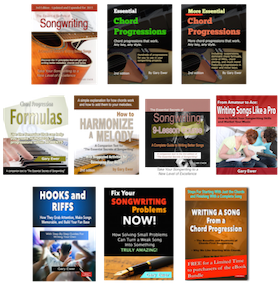 Being a student of songwriting means discovering why the world’s best songs are so good, and, how to use that important info to make your own songs even better. Take a look at “The Essential Secrets of Songwriting” eBook Bundle packages, and become a top-level songwriter. Read more..
Being a student of songwriting means discovering why the world’s best songs are so good, and, how to use that important info to make your own songs even better. Take a look at “The Essential Secrets of Songwriting” eBook Bundle packages, and become a top-level songwriter. Read more..
______________
 Melodic range refers to the distance between the lowest and highest note of a melody. The range of songs doesn’t have a lot to do with genre or even the decade the song was written. Some songs use a large range, such as with “You’ll Never Walk Alone“, from “Carousel” (1956), all the way to Katy Perry’s “Firework“.
Melodic range refers to the distance between the lowest and highest note of a melody. The range of songs doesn’t have a lot to do with genre or even the decade the song was written. Some songs use a large range, such as with “You’ll Never Walk Alone“, from “Carousel” (1956), all the way to Katy Perry’s “Firework“.
But some songs are tremendously successful with a much more constricted range, such as with Elvis Presley’s “Hound Dog“, for which most of the melody moves up and down within a 3rd.
In truth, the range of the melody is not a terribly important element when determining a melody’s success. Earworm melodies, those tunes that get stuck in our ear and don’t let go, might benefit from using a smaller rather than a larger range. Why? It’s because the repetitive nature of the melody is its most important quality. Short, repetitious melodic ideas are the main ingredient of earworms, and using a smaller range makes it easier to sing.
Earworm or not, the judicious use of repetition is far more important to a song’s melody than range. In “You’ll Never Walk Alone”, the song’s gradual build from quiet to loud, low to high, partnered with its anthem-like chord progressions, all work together to create a perfect climactic ending to the show. In that case, a large, expansive melody is perfect.
So in the composing of song melodies, range should only be an important element if you are considering the singability of the melody. Songs with a larger range require more vocal ability to do well, since most singers’s “best notes” occur within a much smaller interval, usually less than an octave.
Most amateur singers can sing the lower octave of any large-range melody, such as the perennial Christmas favourite “O Holy Night”, but will possibly struggle as the melody moves into the upper octave.
If you’re looking to write a song that you hope practically anyone will be able to sing as they walk down the street, keep the range to within an octave, but beyond that, don’t worry about range. It’s the inner structure of the melody (chiefly its sensible use of repetition) that will make it or break it.
____________
Follow Gary on Twitter
 “The Essential Secrets of Songwriting” e-book bundles will show you how to write great songs, harmonize your melodies, and give you hundreds of chord progressions in the process.
“The Essential Secrets of Songwriting” e-book bundles will show you how to write great songs, harmonize your melodies, and give you hundreds of chord progressions in the process.
PURCHASE and DOWNLOAD the e-books for your laptop/desktop, Kindle, iPad, or any other PDF-reading device.










Pingback: Interesting Links For Musicians and Songwritiers – March 1, 2014 | Creative Music | Inspiring Musical Creativity